What to Know When Evaluating the 5 Best ABM Platforms

Senior marketing professionals have a problem. Many have fallen into the fabled MQL trap. They put plenty of marketing qualified leads (MQLs) into the funnel, but ultimately struggle to impact revenue. Here comes account-based marketing (ABM) to save the day, right?
Not quite.
If you’ve spent any time evaluating ABM platforms, you’ve likely realized two important things:
- Not all ABM platforms are the same
- Few sales and marketing teams rely on a one-size-fits-all solution
In this blog post, our aim is to give you an honest comparison of five of the leading ABM platforms, including:
The goal is to help you determine the best fit for your organization’s short-term and long-term objectives for B2B advertising.
What is account-based marketing?
Enter account-based marketing (ABM), which on paper stands to deliver a few notable benefits:
- Target the most valuable accounts: aligned logos, large enterprises, high potential annual contract value (ACV)
- Fetch higher return on investment versus traditional marketing campaigns
- Personalize campaigns to help cultivate strong in-account relationships
- Align sales and marketing around the same target accounts
While account-based marketing seems like the perfect solution to fill this pipeline gap, there's more to it than meets the eye.
The shortcomings of non-personal account-based marketing
A lot of ABM vendors fall within what we call the non-personal category. That is, they’re really good at passing engaged MQLs and marketing qualified accounts (MQAs) to the sales team. But an account isn’t very specific, is it? And there’s only so much the sales team can do with a qualified account when they don’t know exactly who to reach out to, or what that person might be interested in hearing.
As a result, outbound teams often struggle to improve conversion rates with ABM tools, no matter how many phone calls they make, or emails they might send. And because most of the available ABM platforms don’t enable post-sale targeting, sales teams can’t really rely on them to support revenue retention and expansion within existing accounts.
5 best account-based marketing platforms in 2023
The funny thing about account-based marketing is that it’s not even a product category—it’s a space in which a lot of different vendors can and do fly the ABM flag, but differ greatly when it comes down to the nuts and bolts. Let’s look at five of the top ABM platforms you’re likely to encounter as you evaluate potential solutions.
Influ2
Contact-level ABM
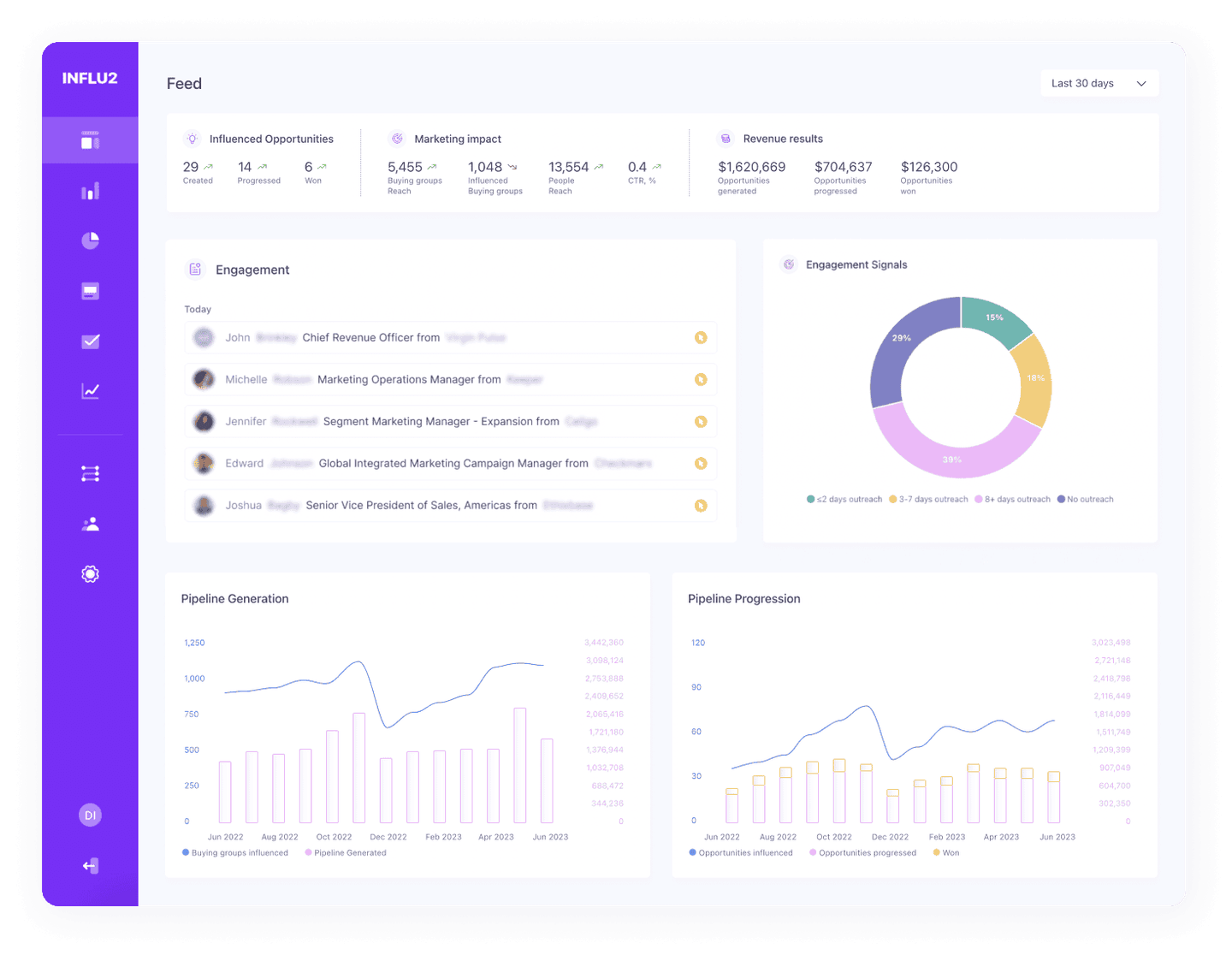
Influ2 enables the targeting of specific people and the provision of contact-level insights to sales reps. Such precision boosts conversion on the key stages of sales cycles (from pipeline generation to customer expansion).
Strengths:
- Provides contact-level intent signals for search, social, and third-party content consumption
- Allows you to target specific decision makers by name and within multiple channels (LinkedIn, Facebook, Google, Amazon, and Instagram), then guide them through an automated sequence of marketing messages.
- Ensures exceptional sales-marketing alignment by sending sales intelligence on who engaged with what ad so that they know exactly what to discuss with that prospect. At the same time, marketers can see if sales reps reacted to this engagement within the platform.
- Revenue reporting helps marketers track and attribute account-based marketing influence from the first time a person saw an ad to the closed deal.
Weaknesses:
- No account-level intent data, only contact-level intent data, so customers need to have a well-defined Ideal Customer Profile (ICP).
- Not a good fit for marketers who don't work in close alignment with sales, as half of the platform is built around enhancing sales-marketing alignment.
- Not the best for marketers who measure success in MQLs and lead form submissions; this platform is specifically built to boost sales conversion and influence pipeline.
Bottom Line:
Influ2 is for accounts moving upmarket that need to break into enterprise accounts, or penetrate niche audiences. It boosts sales conversions, delivers unmatched ROI (according to G2), and plays well with other platforms. And it’s easy to bring in Influ2 to add precision to key stages of the sales cycle that are missing from other ABM platforms that rely solely on IP matching for targeting.
6sense
Account-based marketing software powered by Revenue AI
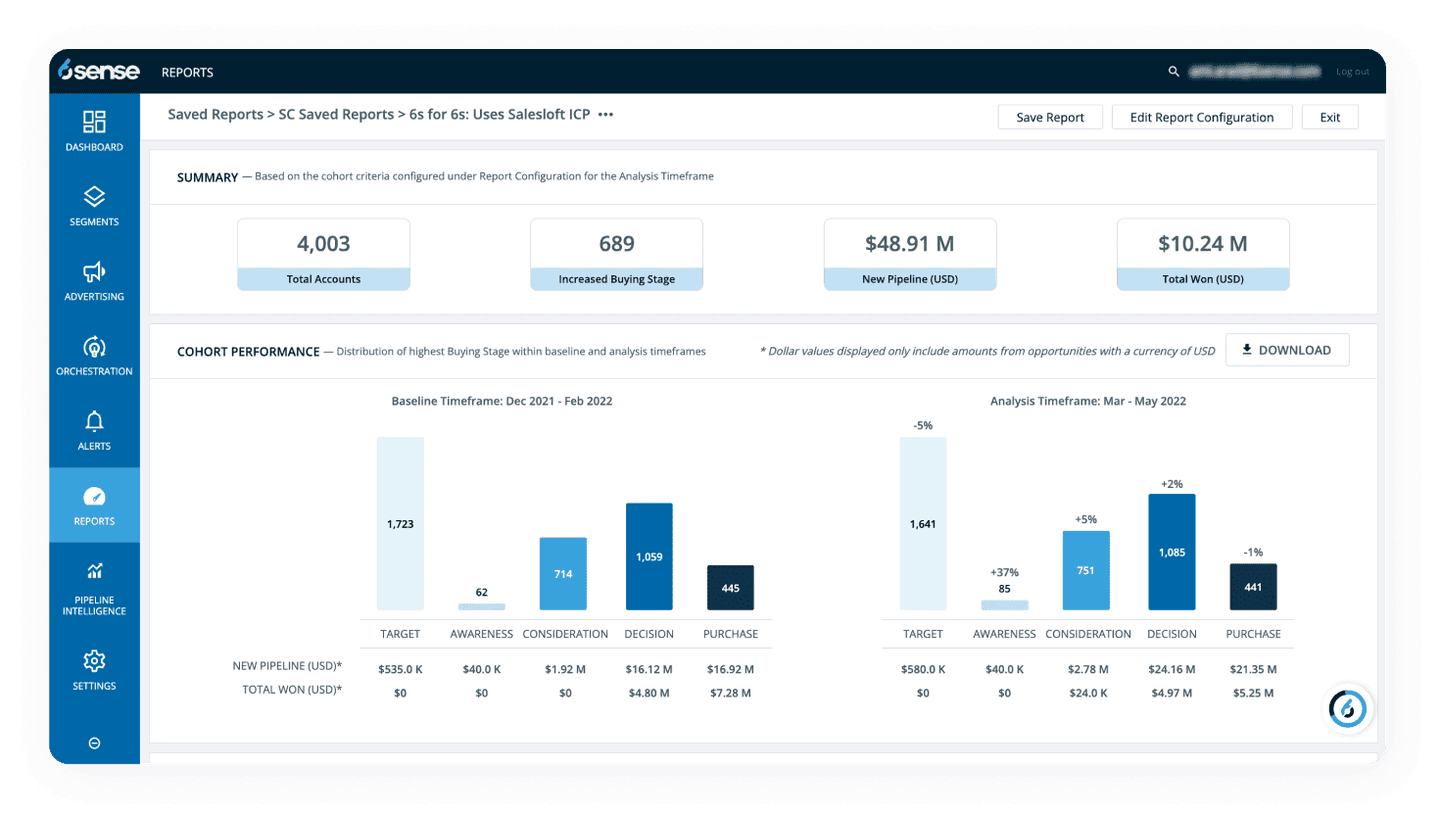
6sense is a marketing and sales intelligence platform specializing in account-based marketing. It uses AI and machine learning capabilities to analyze intent so B2B companies can prioritize outreach to high-value accounts.
Strengths
- Strong account-level intent data that relies on probability to identify the buying stage for target accounts so marketers can prioritize their efforts.
- Detailed account reporting with predictive analytics on go-to-market performance, as well as insights into the pipeline impact of ABM activities.
- Intuitive workflow setup so marketing can trigger workflows for sales based on account scores and push account based marketing campaigns forward.
Weaknesses
- Vague account scoring that makes it difficult for sales teams to know the next best action to take and who to reach out to.
- Limited integrations beyond Salesforce and HubSpot that require significant upkeep, often delaying access to intelligence for salespeople.
- 6sense does not integrate well with some key paid media platforms, such as Facebook and Instagram, while relying mostly on display ads and partially on Linkedin.
- High potential cost for 6sense’s account based marketing plus predictive AI (their premium offering) which leads some customers to find other packages—or combinations of 6sense with other platforms—that make more sense.
Bottom line: Ultimately, 6sense is for teams who need a robust, one-stop-shop ABM platform to help them identify target accounts. Teams without the budget and capacity to properly implement 6sense might find it difficult to drive adoption and realize the platform’s potential ROI.
Demandbase
Account-based marketing software, Go-to-Market tool & B2B advertising platform
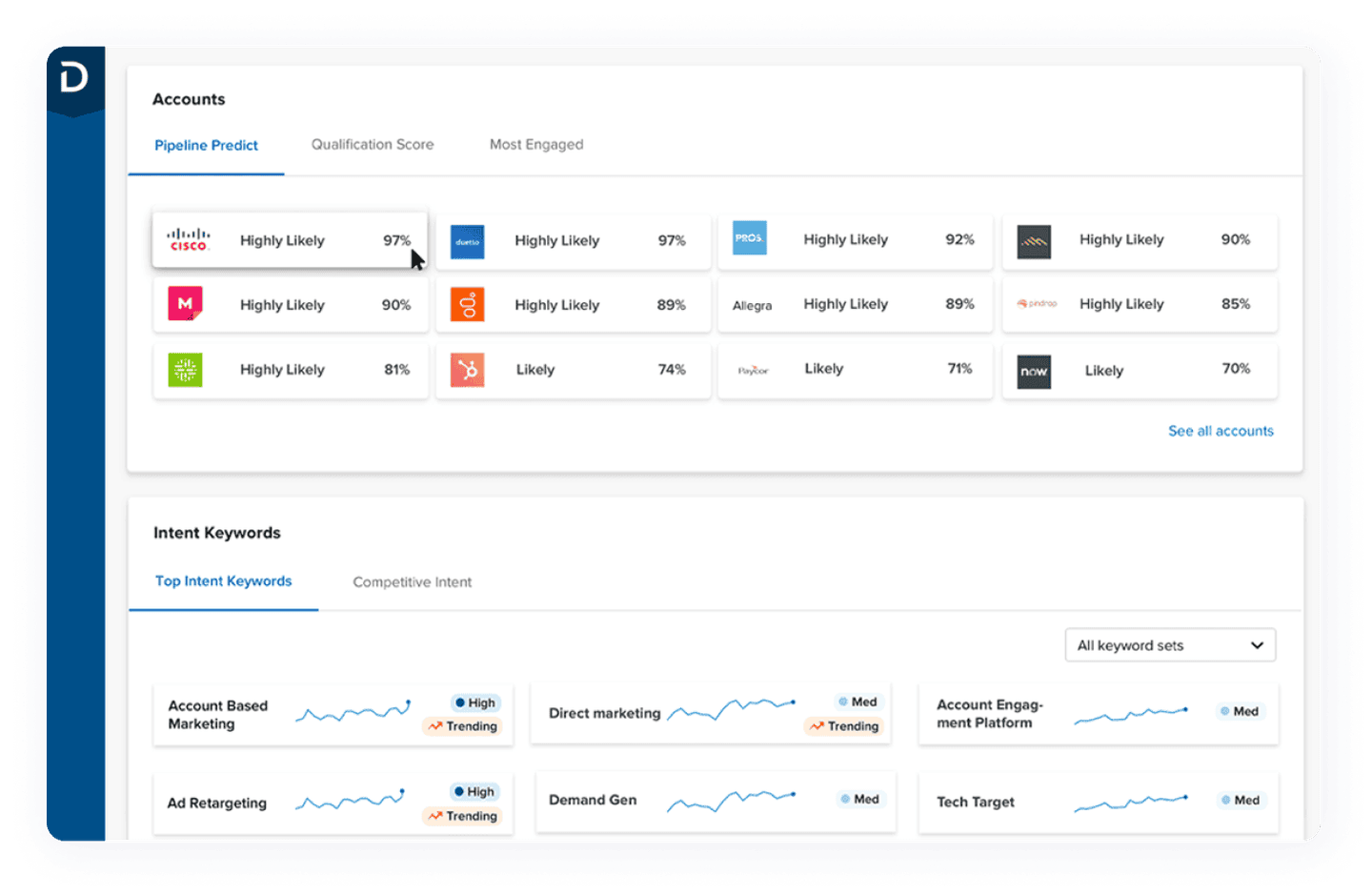
The Demandbase is an ABM platform that helps go-to-market teams target and align on specific accounts. These two principles remain at the core of the company’s philosophy and approach to account-based marketing.
Strengths
- Helping identify in-market accounts—those showing intent on certain products, competitors, or related topics—and enabling marketers to engage them through targeting.
- Pulling info from CRM and marketing automation systems, so you can see how you engage these accounts within other channels (big help to those who can't build reports within their CRM).
- Knowledgeable account managers and service, including resourceful CSMs with marketing experience, as well as prompt technical support.
Weaknesses
- Despite building a demand-side platform (DSP) for B2B, Demandbase’s targeting is based on job level and role, which is still a black box (cannot target contacts and indicate who engaged with your ads).
- Long rollout, steep learning curve due to the size and scope of the platform, which can be quite overwhelming for new users. Implementing the solution and training and onboarding users can require significant time and resources
- Platform latency and bugs including intermittent slowness across the portal and reports, in particular, as well as a fair amount of bugs that may inhibit the user experience.
Bottom Line: For large enterprises with adequate time and resources for rollout, Demandbase can be a powerful ABM tool. Many use the media impressions and intent data to understand how engaged prospects move through purchase journeys; but the platform’s intermittent slowness can impact productivity of your account-based marketing.
Terminus
Account-based marketing tool with a 360-degree multi-channel experience
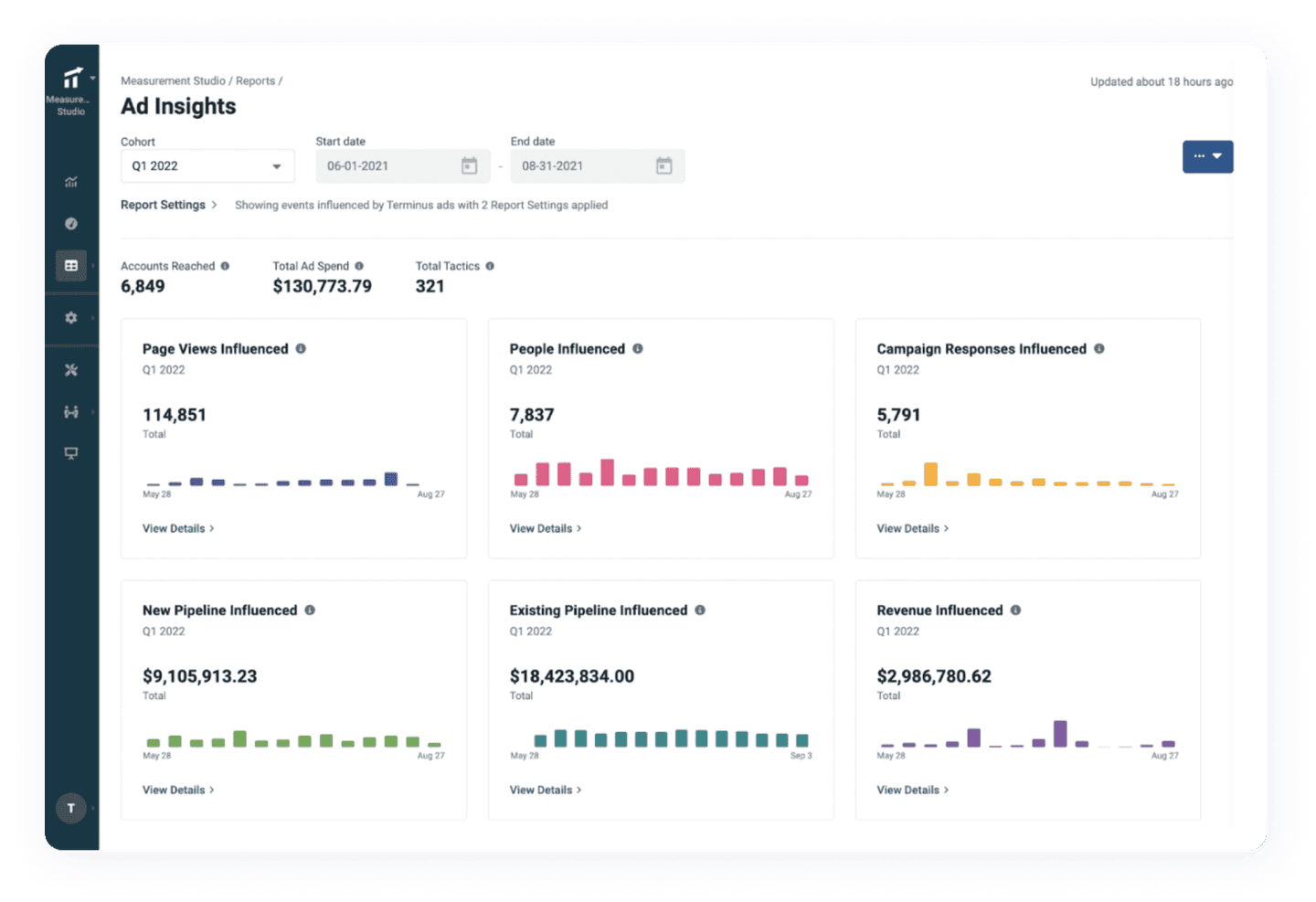
Terminus is a robust ABM platform for marketing teams, known for its advertising capabilities, and long track record in the account-based marketing space.
Strengths
- Account targeting and privacy compliance work well for building awareness within target accounts with ads, while keeping tabs on ad spend and ROI.
- Account identification and segmentation (by geography, company size, etc.) that allow for tailored campaigns, retargeting, automation for accounts that are showing engagement.
- Expert success and support teams with years of experience in marketing, including onboarding, digital media management, and data services.
Weaknesses
- Uses programmatic advertising with a heavy reliance on banner ads, while only sending a portion of traffic to LinkedIn (with no ability to target accounts on other social media platforms).
- Sales pipeline attribution can be less than straightforward for some users, making it difficult to reliably attribute certain account-based marketing activities to influence on pipeline.
- Creative management requires a lot of manual effort and complex audience management may require significant time and training to configure and track
Bottom Line: This is well established ABM software, well-rated among B2B advertising tools. But even mature teams with complex B2B advertising needs sometimes struggle with the platform’s complexities (onboarding, attribution, creative).
RollWorks
Account-based marketing platform for B2B marketing and sales
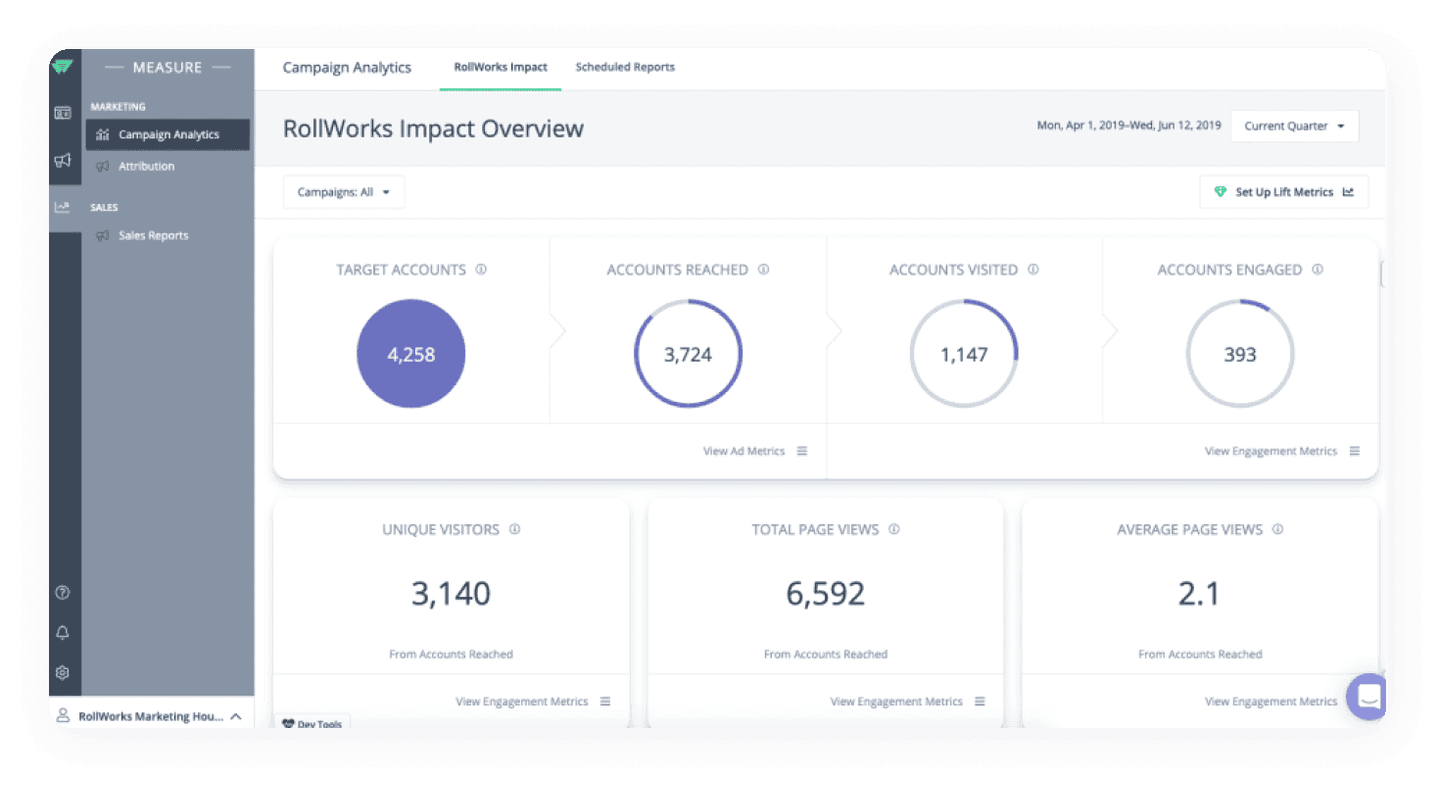
RollWorks is an ABM platform known for its use of IP-targeting, extensive third party data, and user-submitted data when targeting buyers. Their approach is usually a good fit for smaller companies.
Strengths
- Works well for building brand awareness thanks to a notable analytics dashboard offering insights into campaign performance.
- Retargeting is easy to set up and helps teams re-engage target accounts that have expressed interest in the past.
- An intuitive user interface that makes it easy to upload ads and see data at a glance.
Weaknesses
- Uses mostly banner ads, but cannot restrict the websites that ads are shown on (also, the only available social media platform is LinkedIn).
- Lack of integration and no API creates a lot of manual work, as opposed to automated processes.
- Questions about the quality of customer success and support, especially with respect to product knowledge and client-specific campaign knowledge.
Bottom Line: RollWorks scores particularly well for ease of use among small businesses, who tend to use it for top-of-funnel awareness and lead generation (as opposed to conversion). In some cases, this ABM tool can be difficult to pinpoint ROI for certain use cases.
Know thyself: what’s your goal with B2B advertising?
There’s no question that all five of the best ABM platforms bring something special to the table. So, what is the best account-based marketing software for your business? Clearly, all of these solutions differ in their approach. As you search for the right fit, be sure to first answer a few questions:
- What’s your goal with account-based marketing? To drive brand awareness and create MQLs? Or to influence the pipeline?
- Which marketing and advertising channels are most important to your business goals?
- What kind of budget and timeline constraints do you have for this investment?
- Can the platform vendor provide case studies for companies like yours?
- What are your must-have features and benefits?
- What are your non-negotiable integrations?
The answers to these questions will help you evaluate these five best ABM tools and make an informed decision.
One thing we do know is that the same underlying issue faces modern sales and marketing teams. With inbound funnels increasingly drying up, those in senior roles must find an effective outbound playbook, one capable of engaging the right members of the buying team, influencing decision making, and shortening sales cycles.
What many customers are finding out is that, without a means for reaching actual people—by name and on purpose—the return on investments in outbound will continue to stagnate.

Daria Ivanova is a Marketing Director at Influ2. Before taking on her current role, Daria led Influ2’s ABM initiatives advocating for the importance of humanized B2B advertising. Her expertise extends beyond digital marketing and into the open waters as a cross-continental swimmer. So, conquering challenging long-term projects is something she does without a second thought.


